|
"The more extensive a man's knowledge of what has been done, the
greater will be his power of knowing what to do."
- Benjamin Disraeli
13. The Ultimate Clue
Every scrap of cycle evidence that we have been able to collect and
preserve during the past thirty years can be found in our library at
the Foundation. To the best of my knowledge our library contains the
most comprehensive collection of cycle material in the world. It is
divided into three main sections.
In the Data and Research section we have figures concerning several
thousand "time series." A series is a string of figures arranged in
some order. A time series is a string of figures arranged in order
of time. "Average annual wheat prices in the United States since
1864" is a time series. So is "Average daily temperature at Boston
since January 1, 1967." Here you can locate data about earthquakes,
tree-ring thicknesses, geological deposits, rainfall, temperature,
barometric pressure, auroras, sunspots, planetary positions, wars,
animal abundance, disease, prices, production, crops,
transportation, trade, etc.
Many of the records go back for hundreds of years, some for a
thousand. A few, such as war, sunspot maxima, geological deposits,
certain tree-ring measurements, aurora, and earthquakes, extend
backward to the pre-Christian era. This section also contains the
work papers from any research that we have done on any of these
series of figures, either by longhand or by means of the computer.
The second section of the library is where we record the cycle work
of others. It contains thousands of articles and clippings and books
and reprints of papers in scientific journals alleging cycles of
various lengths in the hundreds of phenomena in which such behavior
has been observed.
If someone has written that there is a six-year cycle in the
abundance of gumbos (or someone has written that there is not), you
will find the information here if we have it. Each item in this
section is cross-catalogued by branch of science. Thus if a
particular paper alleges cycles of a particular length in weather,
earthquakes, sunspots, and prices, it is cross-indexed under
climatology, geology, astrophysics, and economics. Conversely, if
you are interested in geologic cycles you could go to the geologic
section of the cross-index file and find the names of all the papers
we have in the library in which geologic cycles are recorded and
alleged.
The third section of our library is perhaps the most interesting. It
is concerned basically with interrelationships - and particularly with
interrelationships that might throw light on the cause of cycles.
If someone discovers that snakes are more active when exposed to
ultraviolet light, his paper about it is filed here. Then if it is
ever discovered that the ultraviolet light reaching the earth has
cycles of some particular wavelength, and that some biological
phenomena have corresponding cycles, we may be able to get a hint as
to the mechanism involved.
If radio weather fluctuates with planetary movements and angular
relationships, as it does, maybe other behavior fluctuates this way
also. We may not know just what mechanism relates the two phenomena,
but we know that there is one. And the mechanism that serves to
communicate to the earth the repercussions of whatever it is that
happens when the planets bear certain angular relationships to each
other may also be the mechanism that conveys faraway cyclic energy
forces to earth. It is worth knowing more about.
I could go on and on about all the strange interrelationships that
are alleged in the third section of our library.
For instance, here
we will learn that when pigeons are released in the neighborhood of
radio towers, they cannot orient themselves; that if I stand near
you, I will affect the flow of electric current from your hand to
your head; and that artificial electric fields will cause dowsers'
rods to dip. Some of these allegations need further corroboration,
but they are all interesting and suggest that very minor
electromagnetic forces may have very important physiological and
psychological consequences.
Since a complete catalogue of cycles is as fundamental to cycle
study as a list of animals is to the study of zoology, our library
also contains thousands of index cards detailing specific cycles. As
this collection grew, we were able to begin what has become a
never-ending program of comparative cycle study.
Comparative cycle study is "the name of the game" so far as our work
is concerned. We compare cycles in all phenomena, searching for
similarities and possible relationships among them. For example, the
fact that locusts have a seventeen-year cycle is, by itself, of
little interest to us. But if apple crops also have a seventeen-year
cycle we are intrigued. Is this mere coincidence, or is there
something in the atmosphere that affects both locusts and apple
trees? If so, what is it? And how does it operate?
If the cycle in one thing were unique and could not be related in
length to the length in anything else, it would hold very little
interest for us. The openings through which your hair grows change
shape in cycles, thus creating wavy hair. But there is no reason
even to imagine that a study of these cycles in several people would
show any interrelationship. If there were, I would be interested. As
there is not, I merely record this behavior as an interesting fact.
However, whenever we discover cycles that have the same length in
completely unrelated phenomena, we are put on alert to the
possibility that one of the behaviors is the cause of the other, or
that both behaviors have a common cause. Of course, with the large
numbers of cycles alleged in all sorts of phenomena it would be
remarkable if there were not some with the same length merely by
chance.
But if cycle lengths were random and completely unrelated, wouldn't
you think we would have a fairly even number of cycles of each
length, as many fifteen-year cycles as sixteen-year cycles, etc.?
And if you discovered, instead, that cycles from completely
unrelated phenomena seem to cluster around certain lengths while
ignoring others, what would you think?
Consider, for example, the so-called 9.6-year cycle, of which
thirty-seven out of many possible examples are listed below.
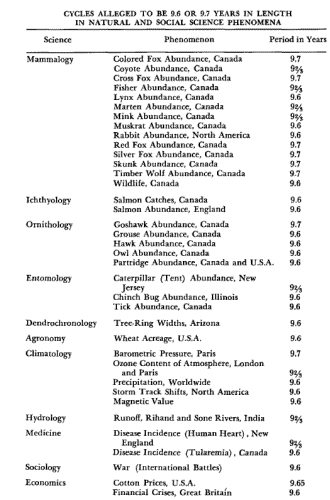
Is it conceivable that all these various behaviors could have cycles
of the same length by chance alone? Or can there be some
relationship among most of them?
The Synchrony of Cycles
Now we come to the heart of the matter.
During the past thirty years, as you have seen, we have discovered
countless cycles that appeared to fluctuate with amazing regularity.
Some of these cycles extend from before the time of Christ, and
their rhythm has continued, almost without interruption, through
wars, panics, revolutions, depressions, industrial change, and
scientific advancement.
We discovered cycles that, after they were distorted, for unknown
reasons resumed their old rhythm. We discovered cycles that
continued to come true after their discovery. We discovered cycles
with the same length and shape in many unrelated phenomena. We
discovered that cycles seemed to reach their highs later and later
as found nearer and nearer the equator. We discovered that cycles
concentrate at particular lengths instead of being evenly
distributed among all lengths.
Were all these pieces in our mosaic clues to the possible existence
of cycles? Yes.
Were they proof that cycles exist? No. Maybe we were just playing
games with numbers. Maybe it was all merely coincidence.
Then we began to look more closely at all the cycles with the same
length, and what we discovered convinced not only me but a large
body of previously doubting scientists that cycles are a reality.
The ultimate clue finally came to light!
We discovered that all cycles of the same length tend to turn at the
same time! They act in synchrony.
Now if it is difficult to find cycles with identical lengths in
unrelated phenomena by chance alone, think how much more difficult
it is to find cycles with identical lengths that also turn at or
about the same calendar time. What amazed us even more was to learn
that all cycles of the same length behave this same way. The
5.91-year cycles all turned closely together, the 9.6-year cycles
all turned closely together, etc. This was unusually powerful
evidence that we were dealing with real and not random behavior.
Sit with me now in our reviewing stand and watch this evidence
parade before your eyes in step to silent drums. But while you
watch, you must not feel superior, for you too march to those same
drums.
You too are in the parade.
The Most Significant Evidence
What you are about to see needs little in the way of explanation.
Here are five diagrams, each showing the timing of all available
cycles of a particular length for which an ideal turning point has
been calculated. The number of years in which each cycle has been
observed is also included. No cycles have been excluded because they
didn't fall into our ideal pattern. Furthermore, as new cycles are
discovered, they almost invariably turn at the same established time
of other cycles of similar length.
The dramatic concentration of the timings exhausts the possibility
of mere coincidence. The demonstrated synchrony of behavior in all
the phenomena that have been timed in each cycle length cannot
reasonably be considered chance (see figures 62-66).
If you study the five diagrams you will note that a few phenomena
are inverted. These particular cycles have their lows while the
others of the same length are having their highs, and vice versa.
Thus we have a synchrony of turning points rather than a synchrony
of highs and lows. It is the nature of some things to be upside down
relative to other things. When your outside temperature is high, the
sale of fuel oil is low. When the yield of crops is high, the price
of crops is low. When physical production is high, the number of
business failures is low.
I suspended personal judgment in regard to cycles for many years. It
was only after we discovered that cycles persisted over hundreds and
even thousands of years, and after we were able to make comparative
cycle studies that showed that substantially all the cycles of any
given length turn at about the same time, that I became convinced
without any lingering doubts as to the significance of at least some
of these behaviors.
It is simply inconceivable that all the observed coincidences could
come about as the result of random forces.
The mystery is real!
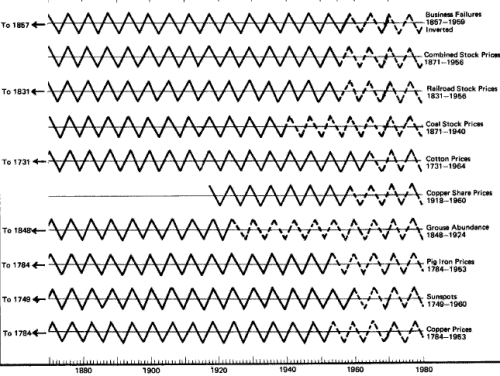
Fig. 62.
The 5.91-Year Cycles
on Parade
Diagram to show timing of idealized crests. Note that here and in
the following
charts crests come close to the same time. This fact suggests an
interrelationship.
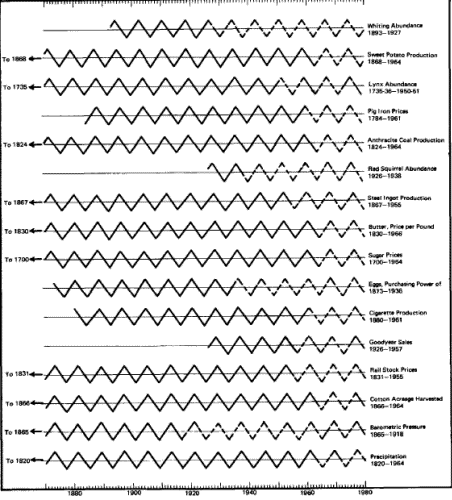
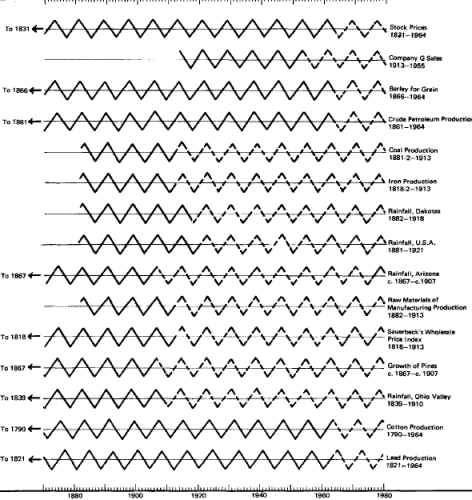
Fig. 63.
The 8-Year Cycles on
Parade
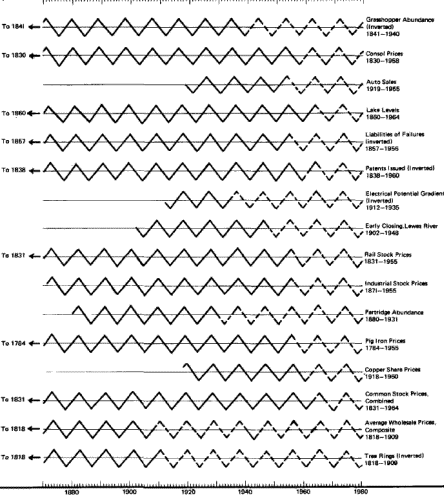
Fig. 64.
The 9.2-Year Cycles
on Parade
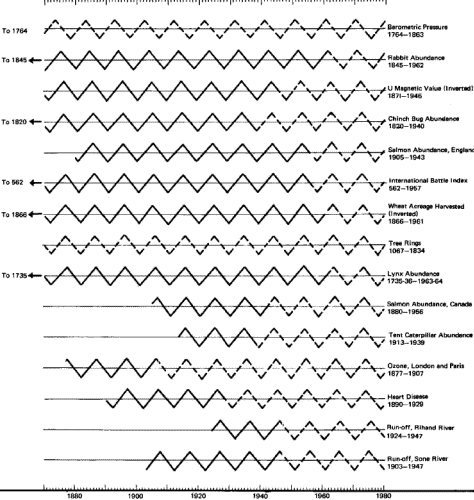
Fig. 65.
The 9.6-Year Cycles
on Parade
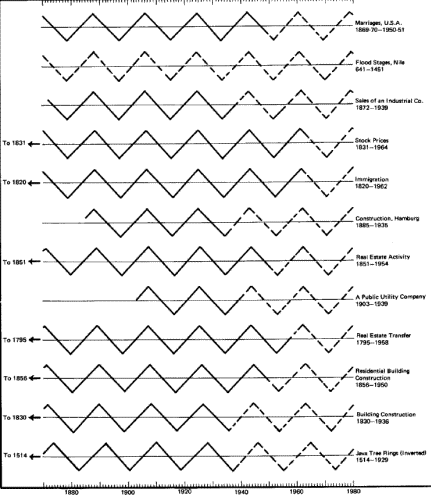
Fig. 66.
The 18.2-Year Cycles
on Parade
Back to Contents
|






